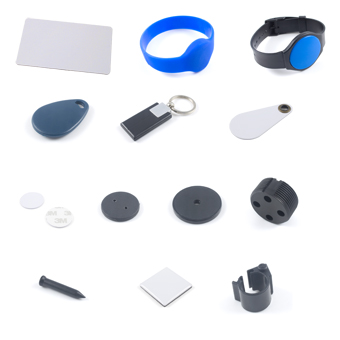RFID Guide
Introduction

RFID (radio frequency identification) systems use data strings stored inside RFID tags (or transponders) to uniquely identify people or objects when they are scanned by an RFID reader. These types of systems are found in many applications such as passport protection, animal identification, inventory control systems, and secure access control systems.
Principles of operation
RFID works on the same principle as a transformer. When the reader is powered up, it gives power to a large coil. The coil creates an external magnetic field which can then be paired with a coil inside a nearby tag. This delivers a small amount of power wirelessly to the tag. With that power, the tag is able to access a small internal memory bank and transmit a key string back to the reader via modulation on the wireless signal.
RFID Protocols
In order for an RFID reader like the 1024 - PhidgetRFID Read/Write to communicate with an RFID tag, they must share a common protocol. This protocol acts as a set of rules for the way data is transmitted wirelessly between the reader and tag. It's common for people to assume that an RFID tag and reader need only share the same operating frequency to be compatible, but they also need to use the same communication protocol. Check the user guide for your device to determine which protocols it supports.
Common RFID protocols:
- EM4100 Series
- ISO11784/ISO11785 (FDX-B)
- ISO18000-2
- ISO10536
- ISO14443
- ISO18000-3
- ISO18000-6
- EPC class 0
- EPC class 1
- EPC GEN II
- ISO18000-4
- Intellitag
- μ-chip
Communication and Effectiveness
RFID tags come in two main varieties: passive and active. Active tags have their own power supply which they use to power an antenna to broadcast data. Passive tags derive the power they require to operate directly from the RF output of the RFID reader, and no other power supply is necessary. This makes passive tags cheaper to produce and much more suitable for common applications whereas active tags are used in situations where very large read distance is desirable(train cars for example are one of the few places active tags are used).
Because passive tags require a strong RF field to operate, their effective range is limited to an area in close proximity to the RFID reader. In the case of the PhidgetRFID, tags brought within approximately 3-4” of the reader can be read. The distance over which the RFID tag is usable is affected by such things as the tag shape and size, materials being used in the area near the reader, and the orientation of the reader and tag in respect to each other and in their operating environment. The smaller a tag, the closer it must be to the reader to operate. A reader's range cannot be increased with any sort of simple modification.
Some varieties of tags such as T5577 support writing. These tags can have any protocol or data written to them.

Multiple Readers
Multiple RFID readers within 1 to 2 meters will interfere with each other. This can be overcome in software by enabling the antennae of individual RFID readers in sequence. Starting with all readers disabled, enable the antenna of the first RFID reader. Wait for 100ms or more to detect any tags. Disable the antenna of the first reader and enable the antenna of the second, and perform another wait cycle and repeat. This can cause some issues if the tag is expected to only be present for a short period of time since a particular reader may be inactive at that moment. For more details on this method, have a look at this article.
The other way to attack this problem is to shield the readers from one another. This is more difficult than it appears on the face of it however. In general this will involve placing metallic barriers between the readers of indeterminate size. The shielding required will vary from set up to set up but sufficed to say, air on the side of more shielding than less shielding in all situations and it may end up that shielding just isn't not drastic enough to work for your system in which case you will have to revert to plan A which is the polling method.
Multiple Tags
While some RFID readers offer the capability to read multiple tags at once, the majority do not. In order to read a tag, any other tags must first be removed from the reader's field of effect.
RFID Tags
RFID tags come in a variety of shapes and sizes to suit various applications. All RFID tags of the same type sold by Phidgets are guaranteed to be uniquely identifiable, and are available as:
- 30mm Disc Tags
- Credit Card Sized Tags
- Key Fob Tags (attach easily to key rings)
- Wrist Strap Tags
- 'Nail' Tags (Could be hammered into a crate)
- Threaded Cylindrical Tags
- Bird Leg Ring Tag
